Grace Elliot's Blog: 'Familiar Felines.' , page 5
July 12, 2015
The Double Life William Powell Frith: a New Breed of Victorian Artist
Looking back at the past we judge what we see by what we know now. To the modern eye, the crowd scenes painted by William Powell Frith are delightfully detailed and evocative of a bygone age, but they are anything but controversial.
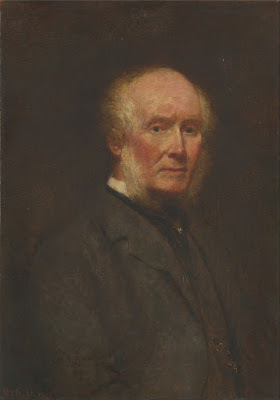 Self portrait of Frith in his 80s.However, to the Victorian eye, when Frith’s “new type” of painting was first revealed it was lambasted as “a tissue of vulgarity” and “a piece of vulgar Cockney business unworthy of being represented even in an illustrated paper.” Ouch!
Self portrait of Frith in his 80s.However, to the Victorian eye, when Frith’s “new type” of painting was first revealed it was lambasted as “a tissue of vulgarity” and “a piece of vulgar Cockney business unworthy of being represented even in an illustrated paper.” Ouch!So what was it that caused such a volley of offence? The scenes which the Victorian critics found so disturbing were those showing ordinary people enjoying themselves. The critics disliked the paintings on so many levels: they depicted the hoy-polloy, the pictures could be read like a story, and many believed them in bad taste.
In short, the choice to not paint wealthy people looking their best, but to mirror real life was nothing short of revolutionary – and didn’t meet with instant approval.
Ramsgate Sands
Indeed the picture which triggered this reaction was Frith’s “Ramsgate Sands”. Here he showed a lot of middle class Victorians enjoying a day out on the beach complete with Punch and Judy Show, donkey rides, children paddling, women reading newspapers, and a boy with a mouth organ.
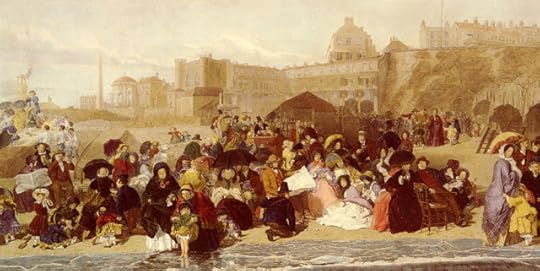 Life at the Seaside, Ramsgate Sands
Life at the Seaside, Ramsgate Sandsby FrithThe scene Frith recorded was a relatively new innovation, the day trip – brought about by the new railway allowing ordinary people to escape for a day to a pleasant location. But the big question was: Is ordinary life worthy of art?
Fortunately for Frith, it seems Queen Victoria approved (despite the critics). Perhaps because she remembered Ramsgate from her childhood, she fell in love with the picture and bought it.
So a fashion began for “gazing” or recording the ever more mobile antics of the ordinary Victorian person.
Derby Day
As a leader in his field, Frith decided to tackle a crowd of epic proportions in his painting “Derby Day”. The race on the Epsom Downs had become an unofficial public holiday and Frith was fascinated by the “kaleidoscopic aspect of the crowd”. Aristocrats, ordinary people, gypsies, pickpockets, prostitutes, tricksters, and politicians all rubbed shoulders at this spectacular event and Frith was determined to capture it. As the Illustrated London News described the event: “[The upper classes] positively to hob and nob with those palpably of inferior to them in station.”
Or as one French visitor put it, “[Derby Day was] an outlet for a year of repression.”
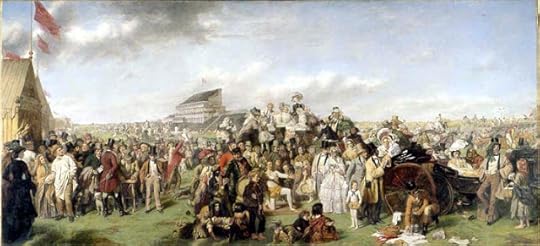 Derby Day
Derby DayUnlike Ramsgate Sands, this picture was a commission, and Frith was encouraged to hire models for his work. His patron had extensive contacts and reputedly asked Frith about the models:“What is it to be this time? Fair or dark, long nose or short, Roman or aquiline, tall figure or small?”
The picture took 18 months to complete, but was an instant success. When exhibited at the Royal Academy, the crowds had to be held back behind an iron screen. Indeed, Queen Victoria and her husband, Albert, visited. Both praised the work but whereas Victoria was effusive in her enthusiasm, Albert was constructively critical and suggested ways to improve the painting!
The Railway Station
Frith strode forward with his next work which depicted travellers at Paddington Station, London. On the right of the painting two detectives arrest a pickpocket, the former based on two actual policemen of the day who posed for Frith. For this painting Frith used his family (or one family…more of this shortly) as models. The lady with a paisley shawl, seeing off her son, is actually Frith’s wife Isabella.
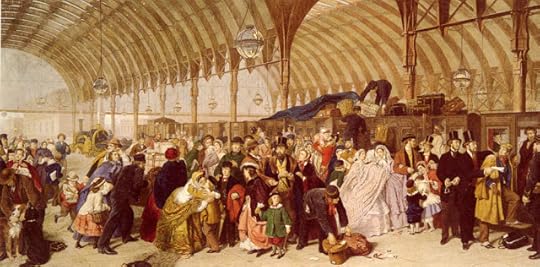 The Railway StationDouble Life
The Railway StationDouble Life
However, Frith was not all he seemed. A seemingly devoted husband to Isabella and father to their twelve children, what his wife didn’t know was that Frith kept a mistress. Just a mile or so distant from the family home, Frith had a duplicate family with his mistress Mary Alford, with whom he had seven children. (It is believed Mary was the model for Frith’s painting, “The Rejected Poet”.)
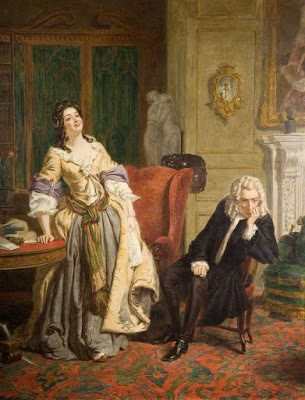 Frith's mistress was the modelThe story goes that for years Isabella was ignorant of this arrangement. But one day she spotted her husband posting a letter – and the game was up. How come?
Frith's mistress was the modelThe story goes that for years Isabella was ignorant of this arrangement. But one day she spotted her husband posting a letter – and the game was up. How come?Well the letter was a loving letter from her husband saying how much he was enjoying himself on a short break by the sea. He was rumbled. Society became aware of the double standards of the artist, and whilst a blind eye was turned, his misdemeanours meant he was never officially recognized by one of his biggest fans, Queen Victoria.
When eventually Isabella died, Frith went on to marry Mary, but his lasting legacy was the abundance of paintings which laid open for all to see, the wide and varied nature of Victorian life.

Published on July 12, 2015 07:26
July 5, 2015
18th Century Propaganda Linked Old Maids to Cats
I dedicate this post to Charlotte – a loyal follower of “Fall in Love with History”.
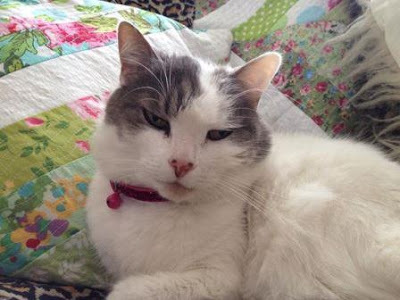 Widget - looking utterly adorableRegular readers of "Fall in Love with History" (like Charlotte!) will have twigged the two things that interest me most are history and cats; so it’s high time for another post melding both together. As part of my ongoing research into all things feline, let's look at how cats were perceived in the past.
Widget - looking utterly adorableRegular readers of "Fall in Love with History" (like Charlotte!) will have twigged the two things that interest me most are history and cats; so it’s high time for another post melding both together. As part of my ongoing research into all things feline, let's look at how cats were perceived in the past.

Old Maid
No I’m not talking about myself, (my ambition is to become a mad-cat-lady in later life, rather than an old maid). But when it comes to cat ownership in the 18th century, the image consistently linked to cat ownership is the older single woman, usually portrayed with warts and a burgeoning moustache i.e. the “old maid”.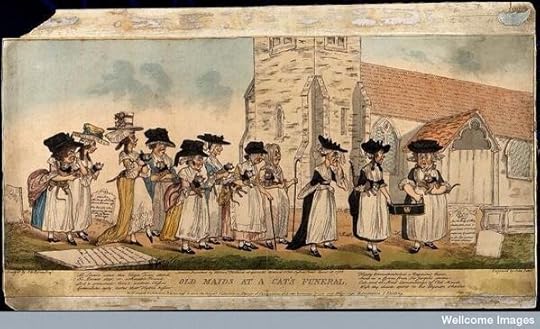 Old Maids Attend a Cat's Funeral.
Old Maids Attend a Cat's Funeral.
Courtesy of Wellcome ImagesFace Value?This is why history is so fascinating, because you can take things at face value: ugly older women kept cats…although this seems rather harsh. But in reality, this stereotype was another example of how the ruling male class kept women in check.
In the 18th century, success to a woman wasn’t about a career, but marrying well, being a good wife, and raising children. Anything that detracted from a woman devoting her life to making men happy was perceived as a threat to the very fabric of society.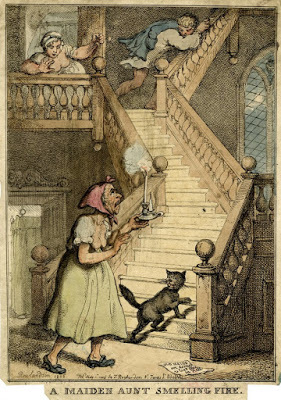
Society CrumblesWhere might it end, if women no longer looked to their husband’s for affection, but sought comfort from pets instead? This bowel-churning prospect for the Georgian male was something that needed stamping out – and what better way to do this than ridicule. Or rather, by making a connection between ugliness and pet cats, by linking loneliness and isolation to pet keeping, so that the young and beautiful were not be tempted to follow the same path.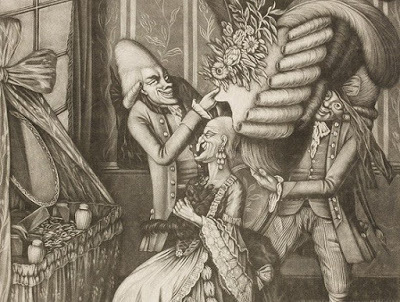 [The eagle eyed will spot the pet clutched to the lady's breast
[The eagle eyed will spot the pet clutched to the lady's breast
is a small dog, not a cat.]Bad PressAt this time cats had a bad press anyway, after previous links to witchcraft and devil worship (largely a result of manipulation of feline reputation by the Catholic Church). Cats were considered a pet of the poor, rather than a luxury. Indeed, their very character was portrayed as treacherous, self-interested, and vicious – not something any young lady in search of a husband wanted to be linked with. The subliminal message was that spending your affection unwisely, i.e. not dedicated to men, led to a lonely, unfulfilled life.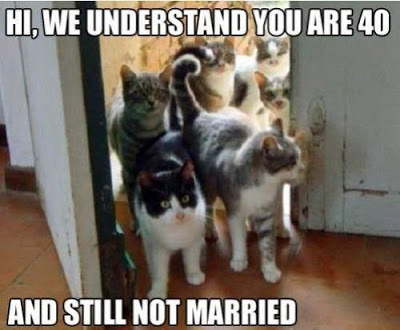
All in all, if you were an older woman in the 18thcentury who loved cats, society was going to take the mickey. Not enough time had passed from cat’s being vilified as the devil’s familiar, and the prevailing view that woman were there to serve men could not cope with a women spending her affection elsewhere.
Just as well I’m a 21st century gal ….
 Widget - looking utterly adorableRegular readers of "Fall in Love with History" (like Charlotte!) will have twigged the two things that interest me most are history and cats; so it’s high time for another post melding both together. As part of my ongoing research into all things feline, let's look at how cats were perceived in the past.
Widget - looking utterly adorableRegular readers of "Fall in Love with History" (like Charlotte!) will have twigged the two things that interest me most are history and cats; so it’s high time for another post melding both together. As part of my ongoing research into all things feline, let's look at how cats were perceived in the past.

Old Maid
No I’m not talking about myself, (my ambition is to become a mad-cat-lady in later life, rather than an old maid). But when it comes to cat ownership in the 18th century, the image consistently linked to cat ownership is the older single woman, usually portrayed with warts and a burgeoning moustache i.e. the “old maid”.
 Old Maids Attend a Cat's Funeral.
Old Maids Attend a Cat's Funeral.Courtesy of Wellcome ImagesFace Value?This is why history is so fascinating, because you can take things at face value: ugly older women kept cats…although this seems rather harsh. But in reality, this stereotype was another example of how the ruling male class kept women in check.
In the 18th century, success to a woman wasn’t about a career, but marrying well, being a good wife, and raising children. Anything that detracted from a woman devoting her life to making men happy was perceived as a threat to the very fabric of society.

Society CrumblesWhere might it end, if women no longer looked to their husband’s for affection, but sought comfort from pets instead? This bowel-churning prospect for the Georgian male was something that needed stamping out – and what better way to do this than ridicule. Or rather, by making a connection between ugliness and pet cats, by linking loneliness and isolation to pet keeping, so that the young and beautiful were not be tempted to follow the same path.
 [The eagle eyed will spot the pet clutched to the lady's breast
[The eagle eyed will spot the pet clutched to the lady's breastis a small dog, not a cat.]Bad PressAt this time cats had a bad press anyway, after previous links to witchcraft and devil worship (largely a result of manipulation of feline reputation by the Catholic Church). Cats were considered a pet of the poor, rather than a luxury. Indeed, their very character was portrayed as treacherous, self-interested, and vicious – not something any young lady in search of a husband wanted to be linked with. The subliminal message was that spending your affection unwisely, i.e. not dedicated to men, led to a lonely, unfulfilled life.

All in all, if you were an older woman in the 18thcentury who loved cats, society was going to take the mickey. Not enough time had passed from cat’s being vilified as the devil’s familiar, and the prevailing view that woman were there to serve men could not cope with a women spending her affection elsewhere.
Just as well I’m a 21st century gal ….
Published on July 05, 2015 07:27
June 28, 2015
"My First Experience of Hades": The London Underground in Hot Weather
June gives way to July, and the weather forecast is for hot weather. This is welcome news for it seems here in the UK we are to get summer weather for a change. However, my husband and son are less keen on the heat because they have a commute into London.
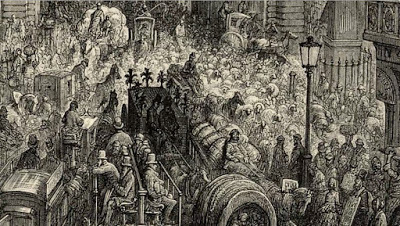 The Underground was devised as an alternative to the busy streets.
The Underground was devised as an alternative to the busy streets.
I have every sympathy with them. Last week, I found a short trip on the Northern Line to be airless, humid and uncomfortable –was enough to make me grateful to get back up into the fresh air. And it seems some things never change is the experience of one Victorian gentleman is anything to judge from.
An excerpt from the diary of R D Blumenfeld, writing in 1887, describes his trip on the underground in terms of a visit to hell. “I had my first experience of Hades today…I got into the Underground railway at Baker Street …I wanted to go to Moorgate Street in the City.”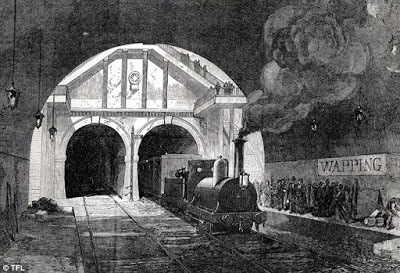
So far so good, but then the unaccustomed heat struck. “It was very warm – for London at least.”
Now our Victorian passenger discovers an additional discomfort.
“The compartment in which I sat was filled with passengers who were smoking pipes, as is the British habit, and as the smoke and sulphur from the engine fill the tunnel, all the windows have to be closed. The atmosphere was a mixture of sulphur, coal dust and foul fumes form the oil lamp above. So that by the time we reached Moorgate Street I was near dead of asphyxiation and heat.”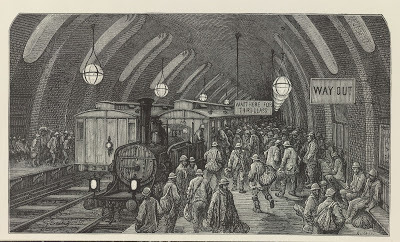
Hot as the modern underground is, at least smoking is not permitted and the tunnels are not filled with smoke and soot from the steam engines. Perhaps Mr Blumenfeld would be surprised to learn the Underground has survived to the modern day, given his prediction based on his experience.
“I should think these Underground railways must soon be discontinued for they are a menace to health.”
Half right then!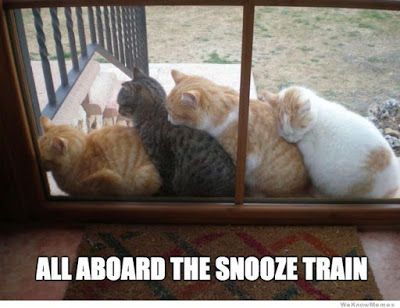
 The Underground was devised as an alternative to the busy streets.
The Underground was devised as an alternative to the busy streets.I have every sympathy with them. Last week, I found a short trip on the Northern Line to be airless, humid and uncomfortable –was enough to make me grateful to get back up into the fresh air. And it seems some things never change is the experience of one Victorian gentleman is anything to judge from.
An excerpt from the diary of R D Blumenfeld, writing in 1887, describes his trip on the underground in terms of a visit to hell. “I had my first experience of Hades today…I got into the Underground railway at Baker Street …I wanted to go to Moorgate Street in the City.”

So far so good, but then the unaccustomed heat struck. “It was very warm – for London at least.”
Now our Victorian passenger discovers an additional discomfort.
“The compartment in which I sat was filled with passengers who were smoking pipes, as is the British habit, and as the smoke and sulphur from the engine fill the tunnel, all the windows have to be closed. The atmosphere was a mixture of sulphur, coal dust and foul fumes form the oil lamp above. So that by the time we reached Moorgate Street I was near dead of asphyxiation and heat.”

Hot as the modern underground is, at least smoking is not permitted and the tunnels are not filled with smoke and soot from the steam engines. Perhaps Mr Blumenfeld would be surprised to learn the Underground has survived to the modern day, given his prediction based on his experience.
“I should think these Underground railways must soon be discontinued for they are a menace to health.”
Half right then!

Published on June 28, 2015 12:39
June 21, 2015
Did Louis Wain's Cat make him Mentally Ill?
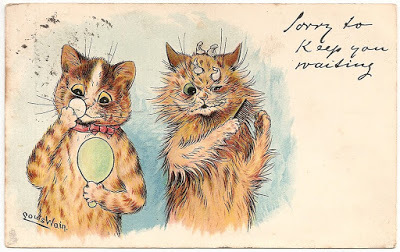 Louis' Wain
Louis' WainCat artistIn the 1900’s the work of artist Louis Wain was as popular as ‘Wallace and Gromit’ are today. Louis drew cat caricatures; anthropomorphosised creatures with huge staring eyes. “Louis Wain invented a cat style, a cat society and a whole cat world. English cats that do not look like Louis Wain cats are ashamed of themselves.” H G Wells. Demand for his work was insatiable; guaranteed to sell any calendar, card or magazine in which it appeared. Cat lover Louis doted on his pets and it was his favourite black and white moggie Peter that inspired his style. However Louis’ success dwindled with a slide into mental illness and the artist ended his days penniless in Bedlam.
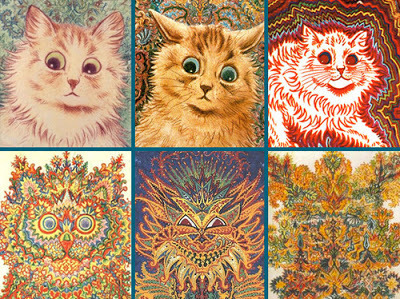 A timeline of Louis' work
A timeline of Louis' workShowing the increasingly disturbed nature of his art
as he descended into mental illnessIn the 1950’s scientists postulated that Louis Wain had suffered from brain cysts caused by a toxoplasmosis infection and pointed the finger at the very cats that were his inspiration.Toxoplasma is a tiny parasite, in fact it’s made up of a single cell. Cat owners, especially pregnant women should be aware of the parasite, because it can cause birth abnormalities in the unborn child (through contact with infected cat feces).
However the link between toxoplasmosis (infection with toxoplasma) with brain symptoms has largely been overlooked, but Louis’ history raises the question of whether indeed his is a case history of brain infection with Toxoplasma.
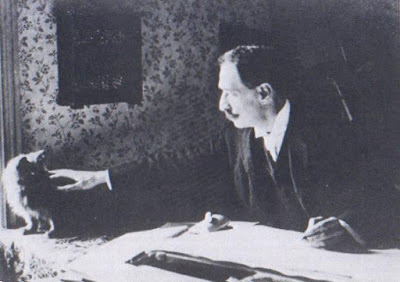 Louis Wain at his drawing table - with cat - in 1890Toxoplasmosis and mental illnessLouis illness manifested itself as erratic behaviour increasingly violent paranoia and agitation. Where as once he had been a gentle, caring man who had nursed his sick wife, he became suspicious of everything and everyone around him; even shouting at a flickering cinema screen for stealing the electricity from his brain.
Louis Wain at his drawing table - with cat - in 1890Toxoplasmosis and mental illnessLouis illness manifested itself as erratic behaviour increasingly violent paranoia and agitation. Where as once he had been a gentle, caring man who had nursed his sick wife, he became suspicious of everything and everyone around him; even shouting at a flickering cinema screen for stealing the electricity from his brain.Studies in the 1990’s (Flegar et al, Lindova et al.) point to chronic infection in people causing subtle behavioural changes, such as slower reaction times and having more car accidents. Holliman’s study of rodents found infected mice had changed behaviour. They had higher dopamine levels; a neurotransmitter associated with novelty seeking and neurotic behaviour. This disinhibited their fear of cat odour and they behaved erractically. Post mortem analysis showed the amgydala to be the most likely site of toxoplasmid cysts, this part of the brain governs social behaviour and emotion, the implication being that brain cysts in humans could indeed present as mental instability and erratic behaviour.
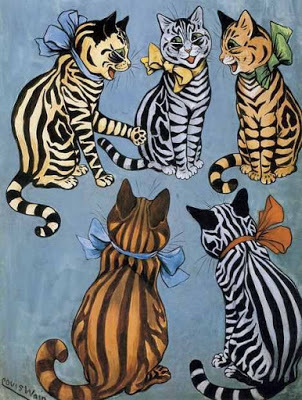
A 2008 study in America surveyed schizophrenic patients and found them to be 25% more likely to test seropositive for toxoplasma than the general population. The significance of this data remains unclear and is currently under further investigation.
Perhaps it is too simple to suggest that toxoplasmid cysts were the sole cause of Louis’ mental illness, but more likely a contributing factor. How likely is it then that his beloved cats were the source of infection?
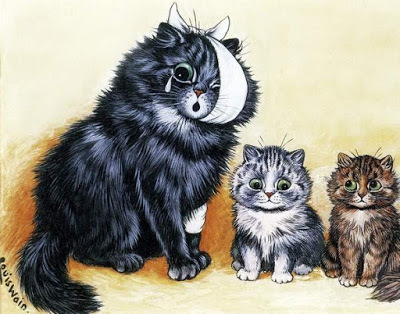
Did ‘Peter the cat’ infect Louis Wain? To find an answer lets consider contemporary studies into cat ownership and incidence of toxoplasma infection.
Two American studies looking at cat-owning pregnant women and HIV patients, found no statistical link between cat ownership and positive toxoplasma serology.
Zoonosis occurs under certain conditions; namely ingesting sporozoites that have had 24 hours to develop from oocysts in cat faeces. Stroking the cat is an unlikely source of infection since most are too fastidious to let faecal contamination persist for long. In addition cats only shed oocysts for a limited time after eating their first infected mouse, and repeat shedding is rare, even in immunocompromised cats. Theoretically there is just a small window of a few weeks after the cat eats his first diseased rodent when his master is at risk from sporozoites in that animal’s faeces.
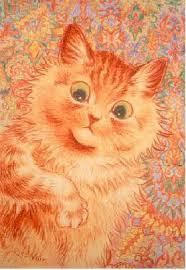
So whilst not wishing to belittle the very real danger of infection from a cat, especially to pregnant women, the risk from a pet maybe lower than perceived and sporozoites in contaminated soil is a far greater source of possible infection. (Obviously no risk is worth taking for a foetus in the womb and so advice must always remain that pregnant women do not empty litter trays and wear gloves for gardening.)
Other sources of Infection.Apart from cat faeces other sources of infections are contaminated soil and water, and raw or undercooked meat.
A Canadian study (Phillips, 1998) showed an alarming 25% of fresh commercial pork and lamb contained microscopic toxoplasmid cysts. If this was the case in the 20th century with modern meat inspection, how much higher the infection rate in Victorian / Edwardian times? It must have been common for cattle and sheep grazing infected pasture to ingest oocysts, form bradyzoites in their muscle and the contaminated meat enter the human food chain.
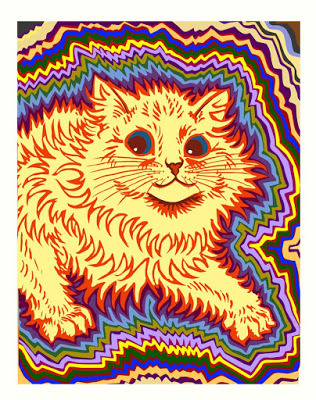
Could it be that Louis Wain’s wife Emily, who he nursed faithfully through her final illness, served her husband undercooked meat? Could she unwittingly have left her husband a legacy that triggered his descent into mental illness? Was ‘Peter the cat’ innocent after all?
“To him [Peter] properly belongs the foundation of my career.” Louis Wain.
What became of Louis Wain? Unkempt and confused Louis was found wandering the streets of London. An admirer of his work, Mrs Chesterton, started a campaign to raise money and save the once popular artist from destitution. Two hundred and thirty eight pounds was raised by the public, which was sufficient to buy Louis a bed at the ‘Bethlem Royal Hospital,’ also known as ‘Bedlam,’ (after the noise made by the in-patients.) so he could end his days with dignity.
As an aside it was here a century earlier, that one Doctor William Battie made his name. Unlike his contempories Dc Battie believed mental illness could be treated and it is from the good doctor that the slang term ‘batty’ (for a mad idea) was derived.
“The whole of Great Britain and Ireland have combined to help us… relieve the famous cat artist.” The Daily Graphic.
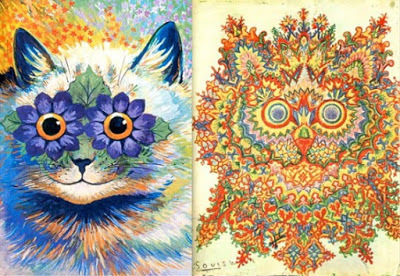
Published on June 21, 2015 12:11
June 14, 2015
Cats and the Law in the 19th Century
Do you own a cat - or rather, does your cat own you? The legal status of cats is an interesting one, not least because it is in a cat's nature to roam and the law acknowledges this, giving our feline friends special dispensation to be "a law unto themselves". This week, I glimpse into the law as it pertained to cats in the 19th century onwards. [If you are interested in medieval laws pertaining to cats, this is covered in an earlier post.]
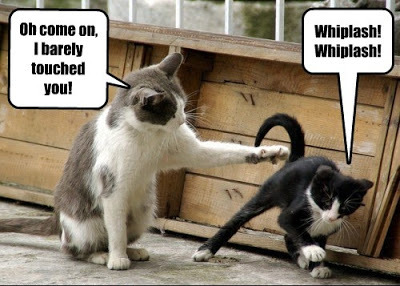
From early 19th century, cats had the legal status of domestic animals, which meant they had a right not to be abused or misused.
That was unless you were a gamekeeper in which case a whole new set of rules applied. Gamekeepers classed cats as “vermin” and as such were permitted to shoot them, especially “poaching cats” spotted stalking the birds under their care.
The law however was determined to give cats’ better protection. "It may be argued that all cats are potential poachers, for that matter all humans are potential law breakers but they are good citizens until proved otherwise."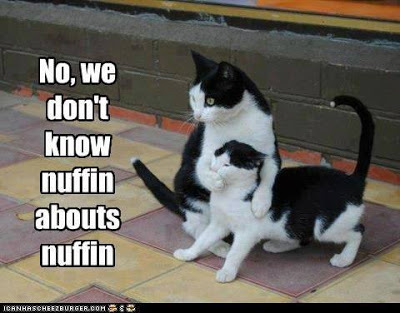
Act of Parliament in 1822 confirmed the cats’ place as a domestic animal, the aim of which was to protect animals from unnecessary suffering. Vivid illustrations exist, courtesy of the Georgian artist William Hogarth, of casual animal cruelty. Hogarth’s series of four pictures titled “The Four Stages of Cruelty” is his protest against:"that barbarous treatment of animals, the very sight of which renders the streets of our metropolis so distressing to every feeling mind"
The artist intended the prints to cheap and readily available to the lower classes, in order to educate about the horrors of animal cruelty. The “first stage of cruelty” shows boys doing such heinous things as putting out a bird’s eyes with a needle, a pair of cats hung by their tails, a dog set on a cat, and a cat thrown out of a window attached to a pig’s bladder.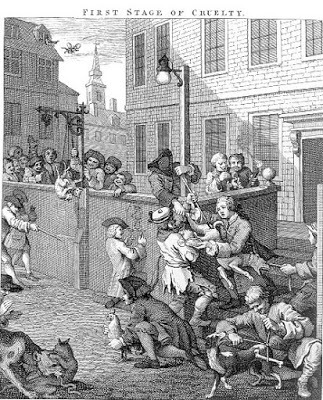 Hogarth's "The First Stage of Cruelty"So if common sense and human compassion could not be relied upon to prevent such wanton torture of animals, then the law must step in.
Hogarth's "The First Stage of Cruelty"So if common sense and human compassion could not be relied upon to prevent such wanton torture of animals, then the law must step in.
People convicted under this new law of 1822 could be subject to imprisonment or a fine, or both, and be banned from keeping animals themselves. To breach this order was a further offence in itself. The maximum fines were rarely enforced, but records exist of a man who willfully neglected two cats that had adopted his wife in his absence. On record as “Not liking cats,” he failed to feed and water them, and then “unreasonably killed a cat in an improper manner.” The result of his cruelty was a total fine of £39 and 4 shillings.
Owning a cat did not (and still does not) require a license and the owner’s rights with regard their cat being their property were shaky or non-existent. It took until 1960s for the law to catch up, and cat owners’ receive some back up in law should their cat be stolen. Larceny Acts (1861, 1916, and 1968) meant theft of a domestic animal was considered a crime, but it took until The Theft Act 1968 to acknowledge that all animals, (cats and dogs), were considered “stolen” when taken without the owner’s consent.
The Protection of Animal Act of 1911, updated in 1970s, lay down more exactly the regulations as to what was cruelty and ill use. This included not performing acts of surgery on a cat or permitting acts of surgery that caused undue suffering. Specifically it made it illegal to castrate male cats without an anesthetic.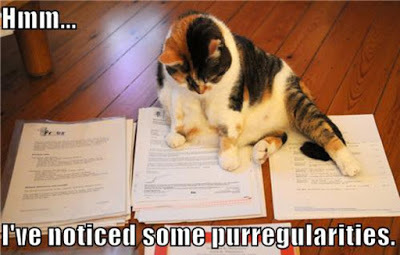
Another interesting area is that of trespass. There is an urban myth that the roaming nature of cats means their owner cannot be convicted of allowing their cat to trespass. However, this is not the case – well, OK, it’s not that clear cut. Cats occupy a unique place in the law. They are exempt from the rules under the Animals Act of 1971, and the laws of trespass do not apply to them. However, the laws of Antisocial Behavior do.
A single cat strolling through a neighbour’s garden might be a nuisance, and not liable to result in the owner’s conviction,. However multiple cats that foul and cause a public health hazard, or those that do damage, might well land the owner in hot water with the law, as has been the case since the Public Health Act of 1936. An owner who repeatedly lets his cats’ foul someone else gardens or regularly prey on their backyard chickens may be subject to an antisocial behavior order (ASBO) which requires him to take action to prevent that behavior.
If you would like to know more about law and cats in the modern day, The Cat Group have put together an excellent and comprehensive document which you can view here.

From early 19th century, cats had the legal status of domestic animals, which meant they had a right not to be abused or misused.
That was unless you were a gamekeeper in which case a whole new set of rules applied. Gamekeepers classed cats as “vermin” and as such were permitted to shoot them, especially “poaching cats” spotted stalking the birds under their care.
The law however was determined to give cats’ better protection. "It may be argued that all cats are potential poachers, for that matter all humans are potential law breakers but they are good citizens until proved otherwise."

Act of Parliament in 1822 confirmed the cats’ place as a domestic animal, the aim of which was to protect animals from unnecessary suffering. Vivid illustrations exist, courtesy of the Georgian artist William Hogarth, of casual animal cruelty. Hogarth’s series of four pictures titled “The Four Stages of Cruelty” is his protest against:"that barbarous treatment of animals, the very sight of which renders the streets of our metropolis so distressing to every feeling mind"
The artist intended the prints to cheap and readily available to the lower classes, in order to educate about the horrors of animal cruelty. The “first stage of cruelty” shows boys doing such heinous things as putting out a bird’s eyes with a needle, a pair of cats hung by their tails, a dog set on a cat, and a cat thrown out of a window attached to a pig’s bladder.
 Hogarth's "The First Stage of Cruelty"So if common sense and human compassion could not be relied upon to prevent such wanton torture of animals, then the law must step in.
Hogarth's "The First Stage of Cruelty"So if common sense and human compassion could not be relied upon to prevent such wanton torture of animals, then the law must step in.People convicted under this new law of 1822 could be subject to imprisonment or a fine, or both, and be banned from keeping animals themselves. To breach this order was a further offence in itself. The maximum fines were rarely enforced, but records exist of a man who willfully neglected two cats that had adopted his wife in his absence. On record as “Not liking cats,” he failed to feed and water them, and then “unreasonably killed a cat in an improper manner.” The result of his cruelty was a total fine of £39 and 4 shillings.

Owning a cat did not (and still does not) require a license and the owner’s rights with regard their cat being their property were shaky or non-existent. It took until 1960s for the law to catch up, and cat owners’ receive some back up in law should their cat be stolen. Larceny Acts (1861, 1916, and 1968) meant theft of a domestic animal was considered a crime, but it took until The Theft Act 1968 to acknowledge that all animals, (cats and dogs), were considered “stolen” when taken without the owner’s consent.
The Protection of Animal Act of 1911, updated in 1970s, lay down more exactly the regulations as to what was cruelty and ill use. This included not performing acts of surgery on a cat or permitting acts of surgery that caused undue suffering. Specifically it made it illegal to castrate male cats without an anesthetic.

Another interesting area is that of trespass. There is an urban myth that the roaming nature of cats means their owner cannot be convicted of allowing their cat to trespass. However, this is not the case – well, OK, it’s not that clear cut. Cats occupy a unique place in the law. They are exempt from the rules under the Animals Act of 1971, and the laws of trespass do not apply to them. However, the laws of Antisocial Behavior do.
A single cat strolling through a neighbour’s garden might be a nuisance, and not liable to result in the owner’s conviction,. However multiple cats that foul and cause a public health hazard, or those that do damage, might well land the owner in hot water with the law, as has been the case since the Public Health Act of 1936. An owner who repeatedly lets his cats’ foul someone else gardens or regularly prey on their backyard chickens may be subject to an antisocial behavior order (ASBO) which requires him to take action to prevent that behavior.

If you would like to know more about law and cats in the modern day, The Cat Group have put together an excellent and comprehensive document which you can view here.
Published on June 14, 2015 12:33
June 7, 2015
Cats and Witchcraft: How Cats became the Devil’s Consort
According to a “Witch Finder Manual” from the 1600s, owning a cat was a mark of a witch.
According to Nicholas Remy, a French witch finder, not only could the devil appear in cat’s form, but cats were basically demonic.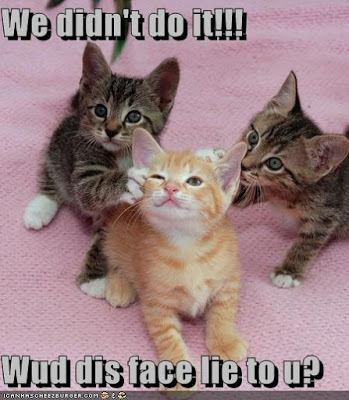
In the Middle Ages cats were persecuted and their numbers fell sharply.So how did things get so bad for cats? How did this anti-cat hysteria come about? Let’s take a look at the reasons why.
Kissing a Cat’s Backside
The starting point for our story is the 12thcentury and a cult called the Albigensians. They worshipped the devil who was good enough to put in an appearance at their satanic masses. The devil took the form of a black cat who demanded the attendees kiss his posterior.
It’s postulated that this explains the other name for the Albigensians – the Cathars – a blend of “cat” and “*rse”. (This is a quaint idea but Cathar actually comes from a Greek word meaning “purified”.) Pope Gregory VII
Pope Gregory VII
Not a big cat loverThe Catholic Church
By 1233, Pope Gregory VII was decidedly twitchy about devil worship, and blamed lack of faith in the Catholic Church as the work of the devil. However, whilst stories broke of devil worship and evil deeds, some counter claims surfaced. People appealed to Pope Gregory's sense of justice, claiming that his Inquisitor, a man named Conrad, had extracted confessions by threatening people with being burnt at the stake.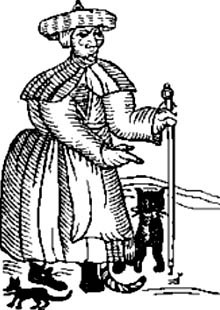 A witch (woman) with her familiar (cat).
A witch (woman) with her familiar (cat).
However, Gregory’s reacted by strengthening the laws, granting his Inquisitors extra powers to persecute suspected heretics. To this end Pope Gregory issued a Papal Bull, the “Vox in Rama” (Voice in Rama). This is thought to be the first official document to condemn black cats as the devil incarnate and effectively became a death warrant for our feline friends.
With encouragement from the church on their quest to stamp out the devil, this link between cats and witchcraft strengthened. Persecution was encouraged, indeed it was mandatory, and to protest was to risk being labelled sympathetic to dark forces.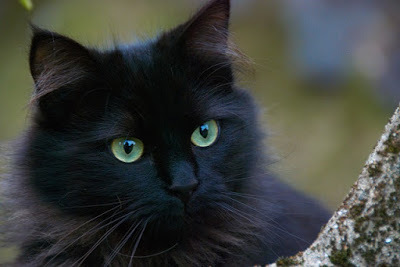
Common Sense Makes things Worse
However, some people still clung to the remnants of common sense. In the 1480s when Inquisitors appealed to a local church for help prosecuting suspected witches, the local clergy refused. Again, the Pope of the day, Innocent XII reacted by beefing up the law.
On 5 December 1484, Pope Innocent issued a Papal Bull, the Malleus Maleficarum. In it he gave explicit instructions about the Church’s duty to stamp out witchcraft. A witch was described as:“Unmindful of their own salvation and straying from the Catholic Faith.”
It seemed witches were responsible for all the ills of the world:“Slain infants…also the offspring of cattle…blasted the produce of the earth, the grapes of the vine, the fruits of the trees”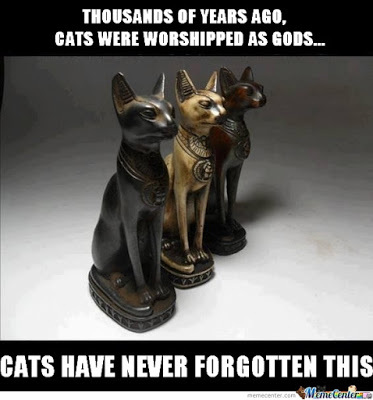
Witches Familiars
Pope Innocent heaped responsibility for a host of terrifying afflictions at the feet of so-called witches, thereby increasing suspicion within communities, and fuelling unease. Cats were said to be a witch’s familiar; a way in which the devil could take on solid form, and so owning a cat became a high-risk occupation if you wanted to stay healthy.
Ironically, Pope Innocent also found a way to twist ill fate in his favour as proof of the malevolence of the witch. He believed that witches had the power of revenge from beyond the grave.
If you think about it, with so few cats around, the rat population rose. With rats came fleas which carried the bubonic plague. Between 1300 and 1700, when cat persecution was at its height, the Black Death roamed unchecked across Europe and must have seemed like the devil was rife. This led to further persecution...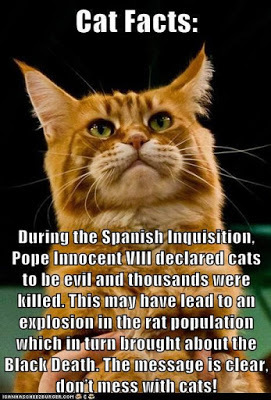
The Ultimate Irony
Whilst people had no idea of the link between rats and the plague, with one in every four people dying of the plague it must have seemed there was evil all around. Ironic, when you think that the cat, which could have helped, was being mercilessly persecuted, and tortured to death at a time of mankind’s greatest need.
According to Nicholas Remy, a French witch finder, not only could the devil appear in cat’s form, but cats were basically demonic.

In the Middle Ages cats were persecuted and their numbers fell sharply.So how did things get so bad for cats? How did this anti-cat hysteria come about? Let’s take a look at the reasons why.
Kissing a Cat’s Backside
The starting point for our story is the 12thcentury and a cult called the Albigensians. They worshipped the devil who was good enough to put in an appearance at their satanic masses. The devil took the form of a black cat who demanded the attendees kiss his posterior.
It’s postulated that this explains the other name for the Albigensians – the Cathars – a blend of “cat” and “*rse”. (This is a quaint idea but Cathar actually comes from a Greek word meaning “purified”.)
 Pope Gregory VII
Pope Gregory VIINot a big cat loverThe Catholic Church
By 1233, Pope Gregory VII was decidedly twitchy about devil worship, and blamed lack of faith in the Catholic Church as the work of the devil. However, whilst stories broke of devil worship and evil deeds, some counter claims surfaced. People appealed to Pope Gregory's sense of justice, claiming that his Inquisitor, a man named Conrad, had extracted confessions by threatening people with being burnt at the stake.
 A witch (woman) with her familiar (cat).
A witch (woman) with her familiar (cat).However, Gregory’s reacted by strengthening the laws, granting his Inquisitors extra powers to persecute suspected heretics. To this end Pope Gregory issued a Papal Bull, the “Vox in Rama” (Voice in Rama). This is thought to be the first official document to condemn black cats as the devil incarnate and effectively became a death warrant for our feline friends.
With encouragement from the church on their quest to stamp out the devil, this link between cats and witchcraft strengthened. Persecution was encouraged, indeed it was mandatory, and to protest was to risk being labelled sympathetic to dark forces.

Common Sense Makes things Worse
However, some people still clung to the remnants of common sense. In the 1480s when Inquisitors appealed to a local church for help prosecuting suspected witches, the local clergy refused. Again, the Pope of the day, Innocent XII reacted by beefing up the law.
On 5 December 1484, Pope Innocent issued a Papal Bull, the Malleus Maleficarum. In it he gave explicit instructions about the Church’s duty to stamp out witchcraft. A witch was described as:“Unmindful of their own salvation and straying from the Catholic Faith.”
It seemed witches were responsible for all the ills of the world:“Slain infants…also the offspring of cattle…blasted the produce of the earth, the grapes of the vine, the fruits of the trees”

Witches Familiars
Pope Innocent heaped responsibility for a host of terrifying afflictions at the feet of so-called witches, thereby increasing suspicion within communities, and fuelling unease. Cats were said to be a witch’s familiar; a way in which the devil could take on solid form, and so owning a cat became a high-risk occupation if you wanted to stay healthy.
Ironically, Pope Innocent also found a way to twist ill fate in his favour as proof of the malevolence of the witch. He believed that witches had the power of revenge from beyond the grave.
If you think about it, with so few cats around, the rat population rose. With rats came fleas which carried the bubonic plague. Between 1300 and 1700, when cat persecution was at its height, the Black Death roamed unchecked across Europe and must have seemed like the devil was rife. This led to further persecution...

The Ultimate Irony
Whilst people had no idea of the link between rats and the plague, with one in every four people dying of the plague it must have seemed there was evil all around. Ironic, when you think that the cat, which could have helped, was being mercilessly persecuted, and tortured to death at a time of mankind’s greatest need.
Published on June 07, 2015 13:20
May 31, 2015
Medieval Life: The Unsavoury Subject of Cat Skins
History is full of unsavoury details which are unpalatable to modern tastes. Recently I’ve been researching cats in history, and repeatedly bumped up against a particularly unpleasant truth. As an obsessive cat lover myself, I’ve debated whether or not to post on this topic.
But my deliberations led me to decide that writing this post might stir debate about why it’s acceptable for certain animals to yield up their skin for human use, but not others. Or indeed, to consider the wider debate about why it’s OK to eat some animals but not others…so here goes…
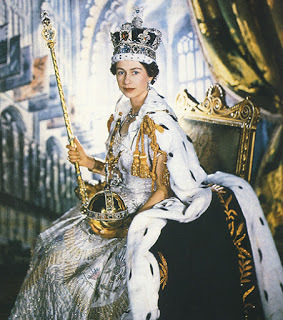 Queen Elizabeth II in her ceremonial robes
Queen Elizabeth II in her ceremonial robes
featuring finest Canadian ermineThe medieval world was very different to ours. Everything had a value, and cats were no exception. They earnt their keep as mousers, and occasionally got their paws under the table as pets. However, few things went to waste in medieval times, and for those unfortunate cats who weren’t prized as hunters or pets, they could sacrifice their skin to keep someone from a lowly caste warm.
The wearing of fur was an important way to keep warm, and the type of fur worn advertised your wealth. This wasn’t just about the purchase price of the fur, but about making sure people didn’t ape those above them in the social rankings. For example, sumptuary laws dictated that people under the rank of knight were only permitted to wear certain “lowly” furs, which include lamb, rabbit, fox…and cat. An ermine - the preserve of Royalty,
An ermine - the preserve of Royalty,
unlike the humble catIndeed, the only type of fur nuns were permitted to wear was catskin or lambskin, whilst monks were permitted to trim their hoods with the pelts from cats, squirrels, lamb, or rabbit, which were all considered lowly animals and a way of reminding the monk they had renounced worldly goods.
The killing of cats for their skins was widespread and taken for granted, as shown in this quote by Bartholomeus Anglais, writing in 1398: “The cat is often taken for his fair skin and slain and flayed.”
A telling detail from a painting by Herionymous Bosch, titled The Wayfarer, shows a pedlar carrying his basket of wares on his back, and from the pack dangles the striped skin of a tabby cat.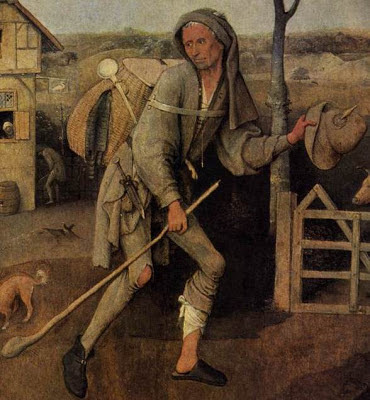 Note both the ragged dress of the pedlar, and the tabby cat skin hanging from his pack
Note both the ragged dress of the pedlar, and the tabby cat skin hanging from his pack
And in Germany, furriers had their own hierarchy with those at the top working with ermine and other costly furs. But when those lower down the rank wished to make a cutting insult they would refer to the colleague as a “cat skinner”, meaning the lowest of the low.
One uncomfortable question is to ask where these cat skins came from. Undoubtedly many were strays and in poor condition, hence the reputation for cat skin as a lowly fur. However, at times, domestic cats also fell foul of a pedlar with an eye to make quick money.Records exist from 1268 in Paris when the going price was one pence for:“…the skins of private cats of the fireside or hearth.”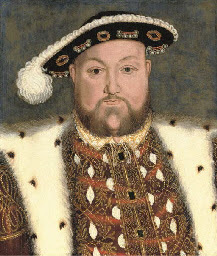 Henry VIII in robes trimmed with ermine.
Henry VIII in robes trimmed with ermine.
Would you feel differently about the portrait if the fur was cat instead of ermine?
Of course in medieval times life was hard and it was practical to use whatever resources were available in order to survive. So using animal skins, of whatever species, was necessary to stop people freezing to death.
As a cat lover, and a vegetarian for over thirty years, I understand why medieval people were so practical about the use of animal skins. Before you throw your hands up in horror, ask yourself are truly blameless? Why is it OK for one species to provide meat for the table (or leather for your shoes), but not another?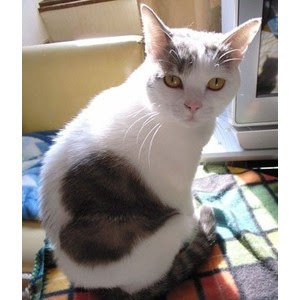 Cat skins look best on the cat
Cat skins look best on the cat
But my deliberations led me to decide that writing this post might stir debate about why it’s acceptable for certain animals to yield up their skin for human use, but not others. Or indeed, to consider the wider debate about why it’s OK to eat some animals but not others…so here goes…
 Queen Elizabeth II in her ceremonial robes
Queen Elizabeth II in her ceremonial robesfeaturing finest Canadian ermineThe medieval world was very different to ours. Everything had a value, and cats were no exception. They earnt their keep as mousers, and occasionally got their paws under the table as pets. However, few things went to waste in medieval times, and for those unfortunate cats who weren’t prized as hunters or pets, they could sacrifice their skin to keep someone from a lowly caste warm.
The wearing of fur was an important way to keep warm, and the type of fur worn advertised your wealth. This wasn’t just about the purchase price of the fur, but about making sure people didn’t ape those above them in the social rankings. For example, sumptuary laws dictated that people under the rank of knight were only permitted to wear certain “lowly” furs, which include lamb, rabbit, fox…and cat.
 An ermine - the preserve of Royalty,
An ermine - the preserve of Royalty,unlike the humble catIndeed, the only type of fur nuns were permitted to wear was catskin or lambskin, whilst monks were permitted to trim their hoods with the pelts from cats, squirrels, lamb, or rabbit, which were all considered lowly animals and a way of reminding the monk they had renounced worldly goods.
The killing of cats for their skins was widespread and taken for granted, as shown in this quote by Bartholomeus Anglais, writing in 1398: “The cat is often taken for his fair skin and slain and flayed.”
A telling detail from a painting by Herionymous Bosch, titled The Wayfarer, shows a pedlar carrying his basket of wares on his back, and from the pack dangles the striped skin of a tabby cat.
 Note both the ragged dress of the pedlar, and the tabby cat skin hanging from his pack
Note both the ragged dress of the pedlar, and the tabby cat skin hanging from his packAnd in Germany, furriers had their own hierarchy with those at the top working with ermine and other costly furs. But when those lower down the rank wished to make a cutting insult they would refer to the colleague as a “cat skinner”, meaning the lowest of the low.
One uncomfortable question is to ask where these cat skins came from. Undoubtedly many were strays and in poor condition, hence the reputation for cat skin as a lowly fur. However, at times, domestic cats also fell foul of a pedlar with an eye to make quick money.Records exist from 1268 in Paris when the going price was one pence for:“…the skins of private cats of the fireside or hearth.”
 Henry VIII in robes trimmed with ermine.
Henry VIII in robes trimmed with ermine.Would you feel differently about the portrait if the fur was cat instead of ermine?
Of course in medieval times life was hard and it was practical to use whatever resources were available in order to survive. So using animal skins, of whatever species, was necessary to stop people freezing to death.
As a cat lover, and a vegetarian for over thirty years, I understand why medieval people were so practical about the use of animal skins. Before you throw your hands up in horror, ask yourself are truly blameless? Why is it OK for one species to provide meat for the table (or leather for your shoes), but not another?
 Cat skins look best on the cat
Cat skins look best on the cat
Published on May 31, 2015 12:33
May 24, 2015
Medieval Monks, Marginalia, and Cats
Your job is boring and repetitive. You ache to express yourself. The only way you can do this is to wait until your supervisor isn’t looking – and doodle on your notepad. Well, this is equivalent to the medieval monks who laboriously copied out manuscripts by hand – and added small drawings of their own invention in the margins.
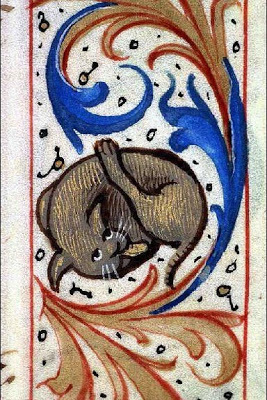 Cats will be cats
Cats will be cats
as in this marginalia illustrationPerhaps the cats that inspired these drawings in the margins (or “marginalia”), also kept the monks company. As the monks drew, so these felines worked alongside, keeping down the rats and mice. This was big problem for the monks because the vermin were attracted to the paper which they ate – destroying all that painstaking work. But the vermin were also bold, and climbed the desks where the scribes worked and stole their food.“Most wretched mouse, often you provoke me to anger. May God destroy you!” [Caption from a humours illustration of a Hildebert, a 12th century scribe, as he tries to catch the mouse that steals his cheese.]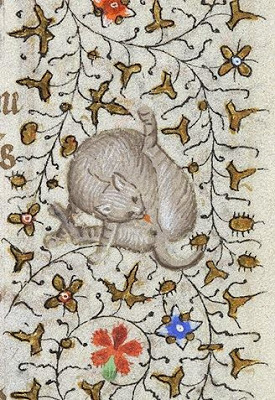 Another cat doing what cats do.
Another cat doing what cats do.
Clearly this scribe was boredBut let’s face it many medieval monks did match the psychological profile of a typical cat lover as creative and intelligent. However, one writer was left his cat’s autograph when the cat stepped in ink and walked across the manuscript.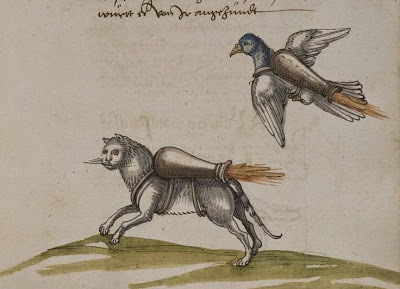 A cat with wearing what appears to be a
A cat with wearing what appears to be a
prototype jet pack
Perhaps another scribe who was perhaps less pleased by his cat’s “signature” was the one who returned in the morning to find a page soaked in cat wee. He was forced to leave that page blank with a message to the effect that nothing was missing but he’d learnt a lesson not to leave books out at night.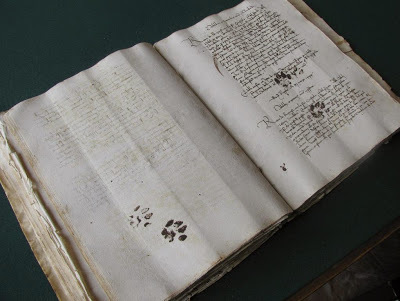 Medieval paw prints captured in ink
Medieval paw prints captured in ink
We know at least one Irish monk welcomed his feline companion. He even gave the cat a name, Pangur Ban, and wrote a rather sweet poem about him:
I and Pangur Ban my catTis a like task we are at:Hunting mice is his delightfulHunting words I sit all night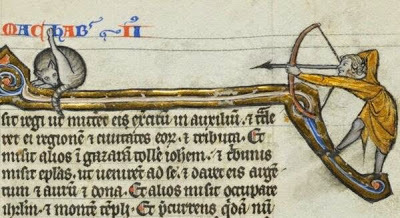 This scribe was not a cat lover by all accounts
This scribe was not a cat lover by all accounts
What is interesting is that whilst cats were valued as mousers, they were also feared as devilish creatures. Indeed, cats were widely used elsewhere in medieval carvings and paintings, to tell ordinary folk cautionary tales of good and evil – where the cat was portrayed as a cunning trickster. Hmmm, I suppose cats have at least got their own back in the 21stcentury, with life on their terms.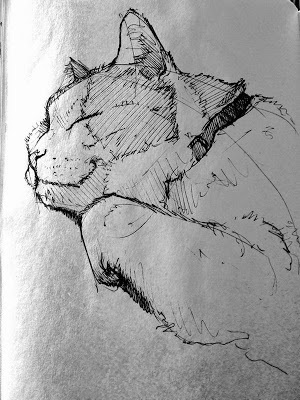 Widget- very much a 21st century cat
Widget- very much a 21st century cat
 Cats will be cats
Cats will be catsas in this marginalia illustrationPerhaps the cats that inspired these drawings in the margins (or “marginalia”), also kept the monks company. As the monks drew, so these felines worked alongside, keeping down the rats and mice. This was big problem for the monks because the vermin were attracted to the paper which they ate – destroying all that painstaking work. But the vermin were also bold, and climbed the desks where the scribes worked and stole their food.“Most wretched mouse, often you provoke me to anger. May God destroy you!” [Caption from a humours illustration of a Hildebert, a 12th century scribe, as he tries to catch the mouse that steals his cheese.]
 Another cat doing what cats do.
Another cat doing what cats do.Clearly this scribe was boredBut let’s face it many medieval monks did match the psychological profile of a typical cat lover as creative and intelligent. However, one writer was left his cat’s autograph when the cat stepped in ink and walked across the manuscript.
 A cat with wearing what appears to be a
A cat with wearing what appears to be aprototype jet pack
Perhaps another scribe who was perhaps less pleased by his cat’s “signature” was the one who returned in the morning to find a page soaked in cat wee. He was forced to leave that page blank with a message to the effect that nothing was missing but he’d learnt a lesson not to leave books out at night.
 Medieval paw prints captured in ink
Medieval paw prints captured in inkWe know at least one Irish monk welcomed his feline companion. He even gave the cat a name, Pangur Ban, and wrote a rather sweet poem about him:
I and Pangur Ban my catTis a like task we are at:Hunting mice is his delightfulHunting words I sit all night
 This scribe was not a cat lover by all accounts
This scribe was not a cat lover by all accounts
What is interesting is that whilst cats were valued as mousers, they were also feared as devilish creatures. Indeed, cats were widely used elsewhere in medieval carvings and paintings, to tell ordinary folk cautionary tales of good and evil – where the cat was portrayed as a cunning trickster. Hmmm, I suppose cats have at least got their own back in the 21stcentury, with life on their terms.
 Widget- very much a 21st century cat
Widget- very much a 21st century cat
Published on May 24, 2015 12:52
May 21, 2015
Welcome, Regan Walker! Shopping on Oxford Street in Georgian London
Grace: I’m thrilled to welcome guest author, Regan Walker to “Fall in Love with History”. Regan posts on the subject of shopping, and contemporary accounts of what it was like to shop on 18th century Oxford Street. Enjoy!
I’m honoured to have read a preview copy of Regan’s latest release, To Tame the Wind, and I loved it. Let’s just say I’d rate Regan on a similar level to one of my favourite HR authors, Tessa Dare. And with 21 reviews to date, all of which are 5 stars, I'd say a lot of readers agree with me.
Anyhow, without further ado…over to Regan.
Shopping on Oxford Street in Georgian London by Regan Walker
Shopping on Oxford Street in the late 18th century? Oh yes! You would have loved it.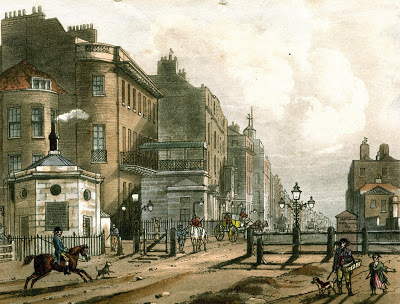 Oxford Street from the Tyburn turnpike end.
Oxford Street from the Tyburn turnpike end.
Hyde Park to the right of the picture.
Today, Oxford Street is a thoroughfare in the West End of London, but its origins go far back to the Roman roads. Between the 12th century and the year of my story, To Tame the Wind, 1782, it was variously known as Tyburn Road, Uxbridge Road, Worcester Road and Oxford Road. It became notorious as the route taken by prisoners on their final journey from Newgate Prison to the gallows at Tyburn near Marble Arch. Beginning about 1729, however, it became known as Oxford Street.
London’s population grew tremendously in the 18th century from about 630,000 in 1715 to 740,000 in 1760. It’s port, the London Pool on the Thames, was the busiest in the world. Much money was spent in building beautiful town houses, pleasure gardens, squares, museums—and shops. To venture into London’s streets was to brave pickpockets, cutthroats, bawds and bullies, not to mention mud and filth, stench from sewage and the black rain from the sea coal that was burned for heating. But on Oxford Street, where window-shopping had become a past time of the upper classes, things were better.
Though Sophie de la Roche, a German visitor to London in 1786, thought the houses in London were not so splendid as those in Paris, she raved about the shops on Oxford Street:We strolled up and down lovely Oxford Street this evening, for some goods look more attractive by artificial light…First one passes a watchmaker’s, then a silk or fan store, now a silversmiths, a china or glass shop. Just as alluring are the confectioners and fruiterers, where, behind the handsome glass windows, pyramids of pineapples, figs, grapes, oranges and all manner of fruits are on show.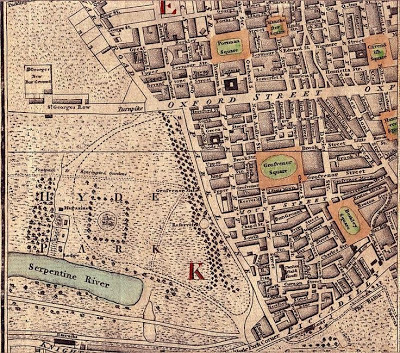 Contemporary map of Oxford Street
Contemporary map of Oxford Street
When my heroine in To Tame the Wind, Claire Donet, goes shopping with Cornelia, Lady Danvers, it is to Oxford Street where they browse the shop windows while Cornelia fills Claire in on the rather interesting origins of the hero, Captain Simon Powell.
While much negative could be said about the streets of London which were ever dirty and plagued by mud puddles, when it came to Oxford Street, Sophie de la Roche noted:
A street taking half an hour to cover from end to end, with double rows of brightly shining lamps, in the middle of which stands an equally long row of beautifully lacquered coaches, and on another side of these there is room for two coaches to pass one another and the pavement inlaid with flagstones can stand six people deep and allows one to gaze at the splendidly rich shop fronts in comfort.
Another visitor to London, de la Rochefoucauld, remarked,
Everything the merchant possesses is displayed behind windows which are always beautifully clean and the shops are built with a little projection on to the street so that they can be seen from three sides.
Of course he is talking about bay windows, seen in many shops today.
At one time London shops displayed painted signs. There were roasted pigs and spotted lions, dogs and gridirons, which had no connection with the things sold in the shop. The signs posed problems, of course, making noise as they creaked in the wind and sometimes falling onto those shopping. In 1766, the signs were removed and to replace them and to tell shoppers what good were being offered, some shops displayed symbols of their trade, like the barber's pole, the grocer's sugar loaf, the golden arm holding a mallet (the sign of the goldsmith). Others put up their names and occupations on signs above their shops. Hence, Mrs. Duval the modiste in my novel (and an actual modiste of the time), though located on Bond Street, featured an spool of thread as well as her name painted on the glass.
One foreign traveler to London, after viewing the new signs, remarked,
‘Dealer in foreign spirituous liquors' is by far the most frequent.
Ha! Some things never change.
 Click for a link
Click for a link
“A sea adventure likeno other, a riveting romance!” NY Times Bestselling author Shirlee Busbee
Paris 1782…AN INNOCENT IS TAKEN
All Claire Donet knew was the world inside the convent walls in Saint-Denis. She had no idea her beloved papa was a pirate. But when he seized Simon Powell's schooner, the English privateer decided to take the one thing his enemy held most dear... her.
A BATTLE IS JOINED
The waters between France and England roil with the clashes of Claire's father and her captor as the last year of the American Revolution rages on the sea, spies lurk in Paris and Claire’s passion for the English captain rises.
To learn more about Regan visit:
Website: http://www.reganwalkerauthor.com/Blog: http://reganromancereview.blogspot.com/Twitter: @RegansReview (https://twitter.com/RegansReview)Facebook: http://www.facebook.com/regan.walker.104
I’m honoured to have read a preview copy of Regan’s latest release, To Tame the Wind, and I loved it. Let’s just say I’d rate Regan on a similar level to one of my favourite HR authors, Tessa Dare. And with 21 reviews to date, all of which are 5 stars, I'd say a lot of readers agree with me.
Anyhow, without further ado…over to Regan.
Shopping on Oxford Street in Georgian London by Regan Walker
Shopping on Oxford Street in the late 18th century? Oh yes! You would have loved it.
 Oxford Street from the Tyburn turnpike end.
Oxford Street from the Tyburn turnpike end.Hyde Park to the right of the picture.
Today, Oxford Street is a thoroughfare in the West End of London, but its origins go far back to the Roman roads. Between the 12th century and the year of my story, To Tame the Wind, 1782, it was variously known as Tyburn Road, Uxbridge Road, Worcester Road and Oxford Road. It became notorious as the route taken by prisoners on their final journey from Newgate Prison to the gallows at Tyburn near Marble Arch. Beginning about 1729, however, it became known as Oxford Street.
London’s population grew tremendously in the 18th century from about 630,000 in 1715 to 740,000 in 1760. It’s port, the London Pool on the Thames, was the busiest in the world. Much money was spent in building beautiful town houses, pleasure gardens, squares, museums—and shops. To venture into London’s streets was to brave pickpockets, cutthroats, bawds and bullies, not to mention mud and filth, stench from sewage and the black rain from the sea coal that was burned for heating. But on Oxford Street, where window-shopping had become a past time of the upper classes, things were better.
Though Sophie de la Roche, a German visitor to London in 1786, thought the houses in London were not so splendid as those in Paris, she raved about the shops on Oxford Street:We strolled up and down lovely Oxford Street this evening, for some goods look more attractive by artificial light…First one passes a watchmaker’s, then a silk or fan store, now a silversmiths, a china or glass shop. Just as alluring are the confectioners and fruiterers, where, behind the handsome glass windows, pyramids of pineapples, figs, grapes, oranges and all manner of fruits are on show.
 Contemporary map of Oxford Street
Contemporary map of Oxford Street
When my heroine in To Tame the Wind, Claire Donet, goes shopping with Cornelia, Lady Danvers, it is to Oxford Street where they browse the shop windows while Cornelia fills Claire in on the rather interesting origins of the hero, Captain Simon Powell.
While much negative could be said about the streets of London which were ever dirty and plagued by mud puddles, when it came to Oxford Street, Sophie de la Roche noted:
A street taking half an hour to cover from end to end, with double rows of brightly shining lamps, in the middle of which stands an equally long row of beautifully lacquered coaches, and on another side of these there is room for two coaches to pass one another and the pavement inlaid with flagstones can stand six people deep and allows one to gaze at the splendidly rich shop fronts in comfort.
Another visitor to London, de la Rochefoucauld, remarked,
Everything the merchant possesses is displayed behind windows which are always beautifully clean and the shops are built with a little projection on to the street so that they can be seen from three sides.
Of course he is talking about bay windows, seen in many shops today.
At one time London shops displayed painted signs. There were roasted pigs and spotted lions, dogs and gridirons, which had no connection with the things sold in the shop. The signs posed problems, of course, making noise as they creaked in the wind and sometimes falling onto those shopping. In 1766, the signs were removed and to replace them and to tell shoppers what good were being offered, some shops displayed symbols of their trade, like the barber's pole, the grocer's sugar loaf, the golden arm holding a mallet (the sign of the goldsmith). Others put up their names and occupations on signs above their shops. Hence, Mrs. Duval the modiste in my novel (and an actual modiste of the time), though located on Bond Street, featured an spool of thread as well as her name painted on the glass.
One foreign traveler to London, after viewing the new signs, remarked,
‘Dealer in foreign spirituous liquors' is by far the most frequent.
Ha! Some things never change.
 Click for a link
Click for a link“A sea adventure likeno other, a riveting romance!” NY Times Bestselling author Shirlee Busbee
Paris 1782…AN INNOCENT IS TAKEN
All Claire Donet knew was the world inside the convent walls in Saint-Denis. She had no idea her beloved papa was a pirate. But when he seized Simon Powell's schooner, the English privateer decided to take the one thing his enemy held most dear... her.
A BATTLE IS JOINED
The waters between France and England roil with the clashes of Claire's father and her captor as the last year of the American Revolution rages on the sea, spies lurk in Paris and Claire’s passion for the English captain rises.
To learn more about Regan visit:
Website: http://www.reganwalkerauthor.com/Blog: http://reganromancereview.blogspot.com/Twitter: @RegansReview (https://twitter.com/RegansReview)Facebook: http://www.facebook.com/regan.walker.104
Published on May 21, 2015 01:09
May 17, 2015
The Cobbled (?) Streets of Victorian London
Summon a mental picture of Dickensian streets, and if you’re like me, images spring to mind of horses clattering across cobblestones. Actually, whilst cobblestones are an ancient innovation, Dickens would have been more familiar seeing “granite setts” on the better London streets. The ideal road surface needed to be durable, easily cleaned (all that horse excrement!), non slip, and didn’t turn into a bog when it rained.
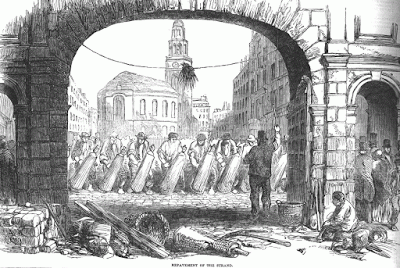 A street being repaved with granite setts
A street being repaved with granite setts
As London grew and expanded rapidly, the search was on for a road surface that could cope with the traffic. One answer was macadam. St James’s Square in the affluent West End was the first London road to use macadam. This is a mix of small granite stones pressed into a prepared surface. Huge, heavy rollers pulled by teams of twelve men were pulled over the surface, compressing it down. This worked well when done properly; however, contractors frequently cut corners to increase their profit margins. Look closely and you'll see these are irregularly shaped
Look closely and you'll see these are irregularly shaped
granite setts rather than cobblesTheir cost cutting dodges included using bigger stones (less effort required to mill them finer) and giving the artifice of smoothness by covering them with sand. First heavy rainfall and sand washed away, exposing a hopelessly irregular surface. Another problem was inadequate rolling flat, which meant the weight of traffic pushed the gravel to one side creating deep ruts in the road. Perhaps an altogether less obvious problem, was poorly laid macadam provide ammunition for the protestors to throw at police at times of disquiet.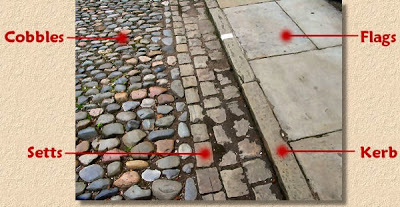 With thanks to www.expertpaving.com
With thanks to www.expertpaving.com
Cobbles are rounder than than rectangular setts
Master engineer Thomas Telford, also in the 1820s, came up with the idea of granite sets. These were stone blocks measuring 11 by 13 inches, and 9 inches deep, set over level ballast. Even when laid correctly, this surface was too smooth and therefore slippery for horses. Labourers regularly had to hammer away with chisels to roughen the surface to give the horses hooves purchase.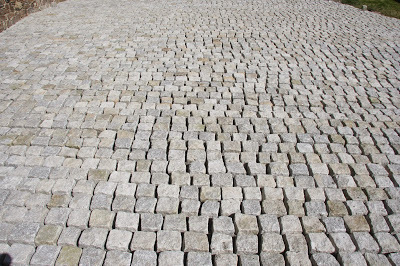 Granite settsBut cutting hard stone to the exact size was an expensive and time-consuming process, and poorly shaped blocks or offcuts often found their way into the roads, providing ruts and holes for a horse to trip on.
Granite settsBut cutting hard stone to the exact size was an expensive and time-consuming process, and poorly shaped blocks or offcuts often found their way into the roads, providing ruts and holes for a horse to trip on.
 The idea behind hardwood roads
The idea behind hardwood roads
A strange solution to the modern mind, but for a while wooden roads seemed the obvious answer. Wooden blocks were easier to cut than stone, and could be dowelled together in the factory, and assembled on site like a giant jigsaw puzzle. The surface was grooved so as to provide grip. Another huge benefit was the wood muffled sound, and was much less noisy beneath hoof or iron wheel. One contemporary reports:“The shopkeepers stat that they can now hear and speak to their customers…even when their windows were open.”The residents of affluent areas clamoured to have this new wonder road surface installed in their square or road, and by the early 1840s Regent Street, Oxford Street, and parts of Holborn had wooden roads.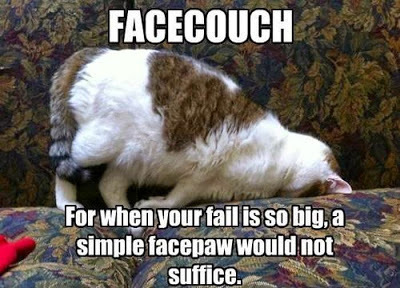
However no one foresaw the rapid deterioration of a wooden road surface – especially one in high use. By 1843 they were in such a poor state that on one stretch, in just four days, 19 horses had slipped and fallen. Indeed, on hills, or in frosty weather the roads rapidly became impassable to equine traffic (at least it kept the noise down!)
Roads which had recently been paved with wood were torn up and resurfaced. Interestingly, a few wooden roads remained in places where quiet was desirable, such as outside the Old Bailey and the Central Criminal Court.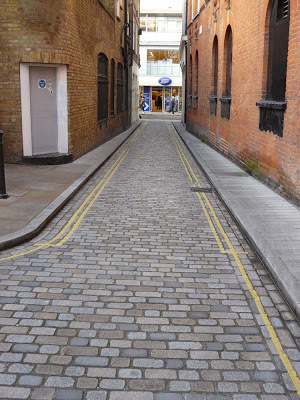
So what of the humble cobble stone? The word “cobble” refers to a rounded stone, of between 2.5 to 10 inches diameter. And before you ask when the Victorian’s invented cobblestones – they didn’t! That honour is a much older one and dates back to the Romans. Their preferred method of building a durable road surface was to use the lumpen strength and reliability of cobbles.
 A street being repaved with granite setts
A street being repaved with granite settsAs London grew and expanded rapidly, the search was on for a road surface that could cope with the traffic. One answer was macadam. St James’s Square in the affluent West End was the first London road to use macadam. This is a mix of small granite stones pressed into a prepared surface. Huge, heavy rollers pulled by teams of twelve men were pulled over the surface, compressing it down. This worked well when done properly; however, contractors frequently cut corners to increase their profit margins.
 Look closely and you'll see these are irregularly shaped
Look closely and you'll see these are irregularly shapedgranite setts rather than cobblesTheir cost cutting dodges included using bigger stones (less effort required to mill them finer) and giving the artifice of smoothness by covering them with sand. First heavy rainfall and sand washed away, exposing a hopelessly irregular surface. Another problem was inadequate rolling flat, which meant the weight of traffic pushed the gravel to one side creating deep ruts in the road. Perhaps an altogether less obvious problem, was poorly laid macadam provide ammunition for the protestors to throw at police at times of disquiet.
 With thanks to www.expertpaving.com
With thanks to www.expertpaving.comCobbles are rounder than than rectangular setts
Master engineer Thomas Telford, also in the 1820s, came up with the idea of granite sets. These were stone blocks measuring 11 by 13 inches, and 9 inches deep, set over level ballast. Even when laid correctly, this surface was too smooth and therefore slippery for horses. Labourers regularly had to hammer away with chisels to roughen the surface to give the horses hooves purchase.
 Granite settsBut cutting hard stone to the exact size was an expensive and time-consuming process, and poorly shaped blocks or offcuts often found their way into the roads, providing ruts and holes for a horse to trip on.
Granite settsBut cutting hard stone to the exact size was an expensive and time-consuming process, and poorly shaped blocks or offcuts often found their way into the roads, providing ruts and holes for a horse to trip on.
 The idea behind hardwood roads
The idea behind hardwood roadsA strange solution to the modern mind, but for a while wooden roads seemed the obvious answer. Wooden blocks were easier to cut than stone, and could be dowelled together in the factory, and assembled on site like a giant jigsaw puzzle. The surface was grooved so as to provide grip. Another huge benefit was the wood muffled sound, and was much less noisy beneath hoof or iron wheel. One contemporary reports:“The shopkeepers stat that they can now hear and speak to their customers…even when their windows were open.”The residents of affluent areas clamoured to have this new wonder road surface installed in their square or road, and by the early 1840s Regent Street, Oxford Street, and parts of Holborn had wooden roads.

However no one foresaw the rapid deterioration of a wooden road surface – especially one in high use. By 1843 they were in such a poor state that on one stretch, in just four days, 19 horses had slipped and fallen. Indeed, on hills, or in frosty weather the roads rapidly became impassable to equine traffic (at least it kept the noise down!)
Roads which had recently been paved with wood were torn up and resurfaced. Interestingly, a few wooden roads remained in places where quiet was desirable, such as outside the Old Bailey and the Central Criminal Court.

So what of the humble cobble stone? The word “cobble” refers to a rounded stone, of between 2.5 to 10 inches diameter. And before you ask when the Victorian’s invented cobblestones – they didn’t! That honour is a much older one and dates back to the Romans. Their preferred method of building a durable road surface was to use the lumpen strength and reliability of cobbles.

Published on May 17, 2015 12:05
'Familiar Felines.'
Following on from last weeks Halloween posting, today's blog post looks at the unwanted image of cats as the witches familiar - from the Norse Goddess Freya to lonely women in the middle ages.
The full Following on from last weeks Halloween posting, today's blog post looks at the unwanted image of cats as the witches familiar - from the Norse Goddess Freya to lonely women in the middle ages.
The full post can found at:
http://graceelliot-author.blogspot.com
...more
The full Following on from last weeks Halloween posting, today's blog post looks at the unwanted image of cats as the witches familiar - from the Norse Goddess Freya to lonely women in the middle ages.
The full post can found at:
http://graceelliot-author.blogspot.com
...more
- Grace Elliot's profile
- 156 followers



